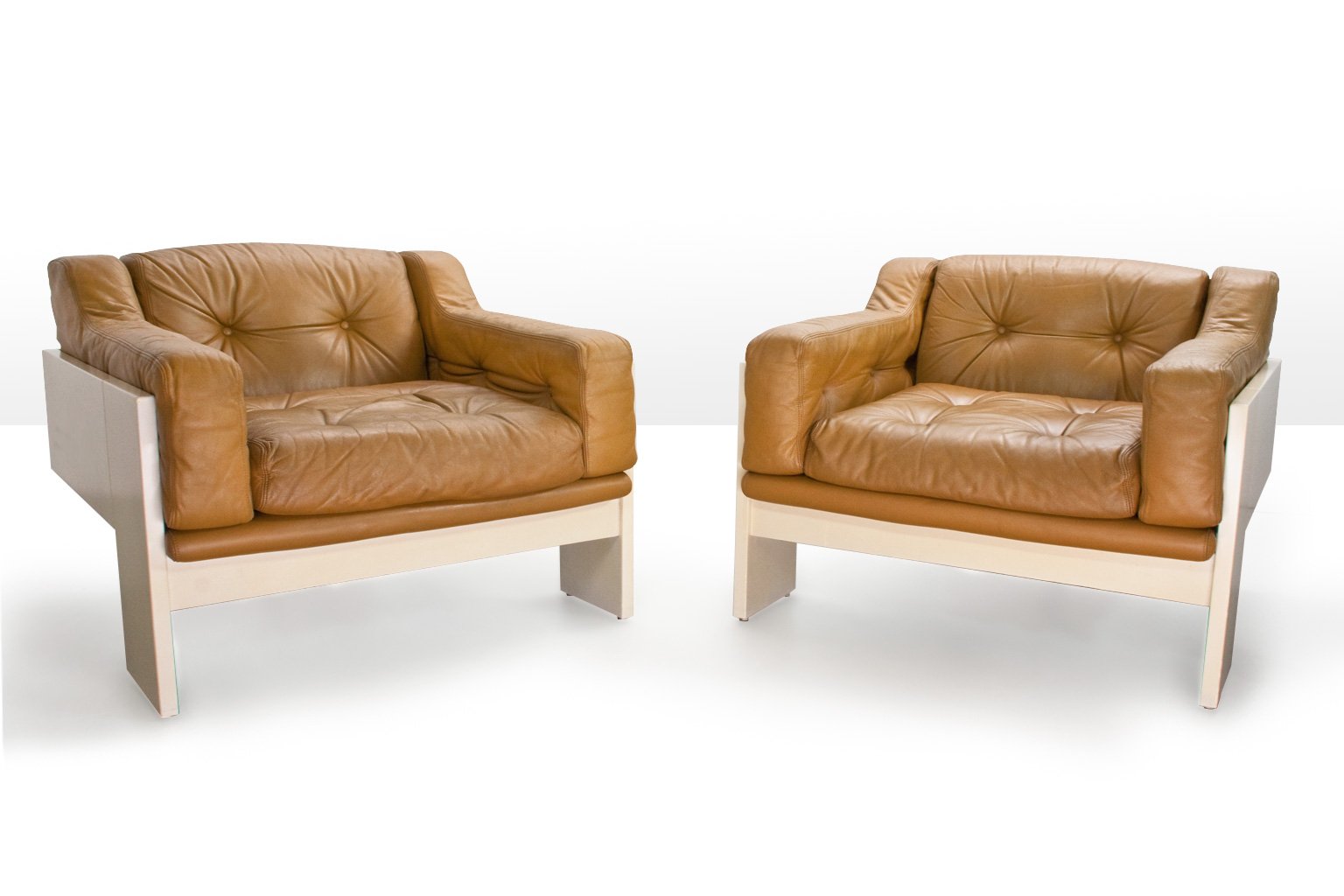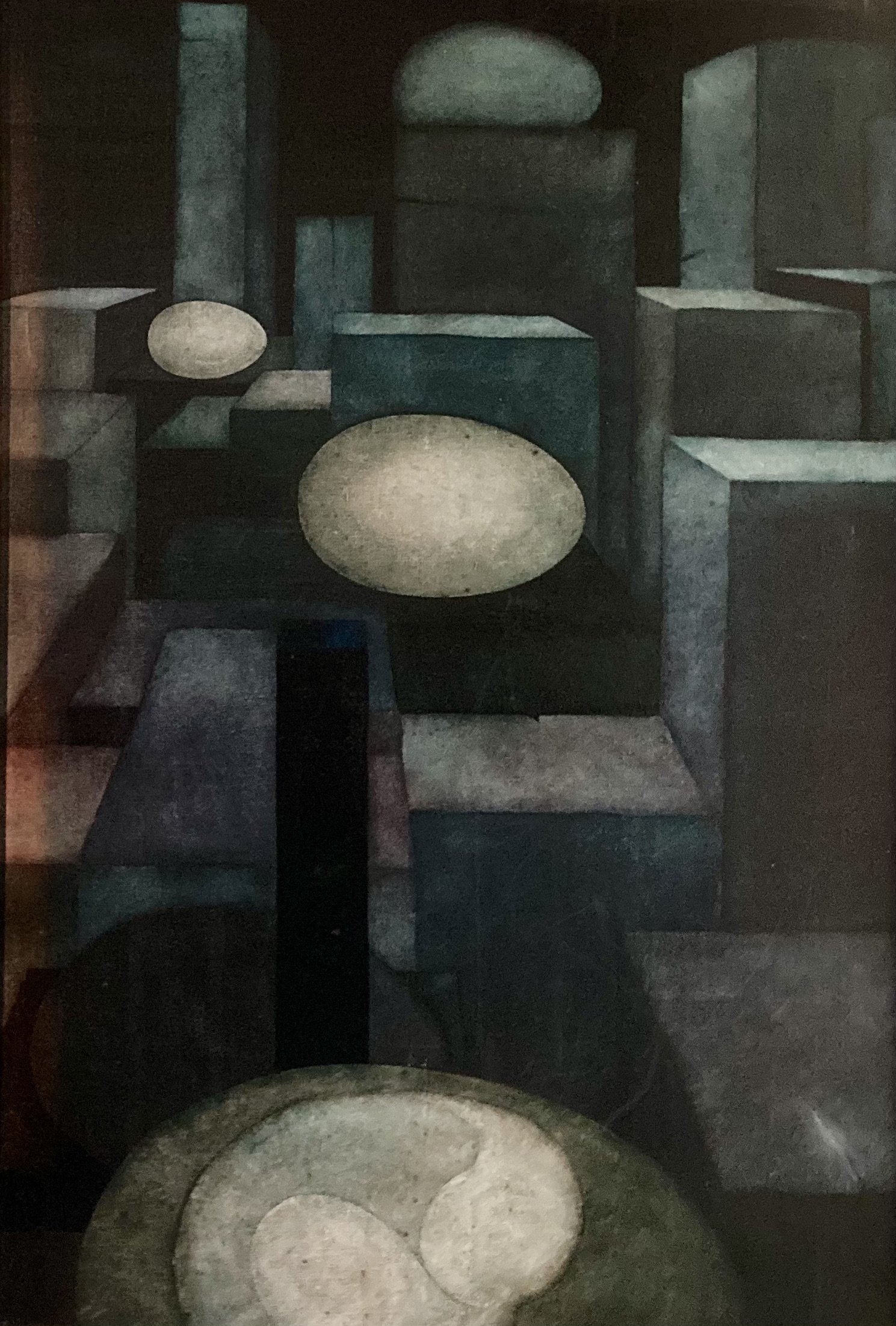“To design is to reject, to draw and redraw. It all starts with an idea, watching and drawing, to shape and reshape.”
Erik Deforce was a Belgian designer, interior designer and artist based in Flanders. He was a passionate adept of Italian and Scandinavian sixties Modernist design, his lounge chair ‘the Lord’ from 1970 being his ultimate top work.
In his visual work, Deforce represents a mysterious world of cosmic archetypes. His paintings and ceramic sculptures depict magical primordial figures of the timeless, mythical life symbols and archetypes of fertility, eroticism and earthly sensuality.
Kortrijk 1937 - Brugge 2012
Erik Deforce - alias Rik or Ric Def, studied at the Royal Academy of Art of Doornik. Upon graduating in 1959 with a diploma in Interior Design he started one of the very first design and life style shops in Ostend specialized in the finest furnitures of modernist Italian and scandinavian sixties design produced by companies like Sormani, Poltronova, Knoll International, Archizoom, Superstudio.
After a start-up on the Wapenplein in Ostend, which he ran together with his wife Helga Dewaele (pianist), they moved to the Adolf Buylstraat in 1962, the year of their marriage, to open a top business with a showroom of more than three hundred square meters called SAGA Design Center.
Saga Design Centre 1963-1970
Through their passion, progressive vision and direct contacts with some of the greatest Italian designers and furniture companies, the store brought together an exceptional collection of modern furniture, design and life style objects. In no time, Saga became an icon of the new modernism that also flourished architecturally in Ostend with the major reconstruction of the city since World War II. Saga was a pioneer and was about the first, in the region of Flanders, to introduce works by Gae Aulenti, Claudio Sallochi, Mario Bernini, Sergio Cammilli, Ettore Sottsass, Angelo Mangiarotti, Tobia Scarpa, Arne Jacobson, amongst many others.
At that time Erik Deforce did many interior designs of modernist villas and apartment houses. Soon after he started to design furniture as well. He collaborated with small family companies of his native region around Kortrijk such as Gervan Izegem, Hi-Plan Ingelmunster, Durlet Izegem, Devrieze Hertsberge.
Interior projets, design and creation
In 1970 Erik Deforce made a remarkable debut with the G-Collection at the 2nd biennale “Interieur ‘70” at Kortrijk. The show was presented by the manufacturer Gervan Compagny based in Ingelmunster, where Deforce was engaged as manager and chief designer of the company. Pieces like the ‘Lord’ now an absolute international vintage classic, ‘Viterbo’ and ‘Twen’, where followed a year later with ‘The President’, ‘Hilton’ and ‘Modulor’, another of his visionary designs. The Lord, Deforce's undisputed masterpiece shows a particularly pure line based on the ergonomics and vertebral structure of the human body. In terms of appearance as well as design, it can undoubtedly stand next to Le Corbusier's famous chaise longue LC4.
Ric Def Design G-Collection LORD by Gervan
Ric Def Design G-collection Viterbo by Gervan
His furniture designs where mostly made in limited editions some even up to only prototypes or small series of a dozen numbers, often privately commissioned. Despite the relatively small production runs some of his designs got international interest. But as often happened in those days, the production of pioneer designers work stranded by reasons of failure in management, marketing, logistics and production capacity. However some of his designs were awarded by the International Design Center Brussels and were represented at places such as the International Design Fair Biennale in Kortrijk, London, Glasgow and Essen. As such his highly acclaimed Jeans Rondo Collection produced by Hi-Plan showed a new vision in making design accessible at democratic prices.
In 1972 Erik Deforce and his wife decided to close down SAGA to concentrate on more creative work. His wife takes up the piano. Deforce wanted to free himself of the increasing responsibilities the business involved and wanted to take up his other passion of drawing and painting. From this moment on he worked as a free lance creator up till the end of his life shifting in diverse periods between design, doing interior design projects, painting and sculpture.
In 1975 stimulated by his friend and mentor inspirer, the artist Yves Rhayé (1936 -1995), Deforce goes for a career as an artist and very quickly came up with his first exhibitions in several Ostend clubs and Galleries.
Art, color and canvas
In his paintings and sculptures, Deforce developed a style of his own that did not fit with the major international art scenes of his time, which he found too avant-garde, experimental, deconstructive or too conceptual. Instead, Deforce explores a visual language that advanced his fascination with the transparency of line and color, the pictorial refinement of content and form, in search of universal meta-forms such as he admired in the work of one of his idols and heroes. Paul Klee. In a sense, painting for Deforce is a portal that opens the way to a poetic expression of an inner world that connects us to the inexplicable desires and mysteries of life, those of birth, life, eroticism and consciousness. As apparitions of the elusive and magical nature of life, his sculptures and paintings look at us, so to speak. They seem like mythical figures in abstract romantic landscapes that offer a more contemplative view of the mysterious dimensions and unconscious drives that determine and surround life.
Erik Deforce La ville cosmic, oil on canvas
Deforce's paintings are dark-transparent, veil-like and devoted to the night. They show the metaphysical horizon behind the veil of reality. They depict the night watchmen, the seeing of the inner eye, the enchantment of the world in the colorful glow of the night. The night as the time of the unconscious. The time when distinction and determination are impossible. The time of love. The time of Eros. The time of angels and demons who dwell in the surreal dimensions of the mind. The night as the veil of light, the color of the invisible. The night that offers access to that other world, which hides and at the same time reveals what is hidden.
The subtle and dark color palette of Deforce's paintings shows his predilection for the old glazing technique. His paintings have a pronounced palette of glowing earthy colors that have been built up by the slow superimposition of several transparent layers of paint. Various shades of the same color are applied one above the other in thin layers of diluted oil paint, resulting in a great depth effect and a wealth of iridescent colors.
As a sculptor Deforce did not like to chisel or carve but just like Rhayé went into ceramics and used various techniques of modeling clay like ‘columbin’, finished during firing with various patines of bronze, silver and gold enamels.
In his visual work, Deforce represents a mysterious world of cosmic archetypes. His paintings and ceramic sculptures depict magical primordial figures of the timeless, mythical life symbols and archetypes of fertility, eroticism and earthly sensuality. They are symbolic representations of the more mythological dimensions of creation in the form of abstract phallic totems, fertility goddesses, and androgynous or hermaphroditic beings. These creatures live in a silent, symbolic world surrounded by an atmosphere of sultry sensuality. Many of the works depict universal shapes and themes such as the egg, the eye, the moon, the sun, the veil, the night, the horizon... in addition to owls, madonnas, goddesses and medusas, plant, vein, branch or brain structures , anthropomorphic silhouettes, the male and female sexes, breasts and pregnant bellies, all linked together into mythological androgenic prototypes of human nature.
Deforce's style is personal, idiosyncratic and clearly recognizable. Many works breathe in an atmosphere that balances somewhere between surrealism and Flemish magical realism. In that sense, Deforce's aesthetic closely resembles the kind of magical-surrealist-anthropomorphism of similar artists who sprouted from the Flemish clay soils such as Yves Rhayé, Hubert Minnebo, Jef Van Teurenhout, Octaaf Landuyt, Jacky De Maeyer. In their attempt to transcend the "condition terrestre", these artists created mythical creatures and magical landscapes each in their own way. They seem to be silent witnesses in a strange and mysterious kind of garden of delights where eroticism and spirituality transcend and carry the viewer's eye into the ethereal and elusive power of the image.
Design, art and interior projets
From the 1980s, Deforce continued to work regularly and for longer periods as a designer, interior architect and artist. His first marriage turns in a divorce and gets remarried to Adi Pinckers with whom he settled down in Knesselaere in a farmhouse he had restored. His style became more and more eclectic, especially in his furniture design.
Erik Deforce D&D collection Bugghy coffee table
In the 1990s and in the first decade of the 21st century, new series of designs were realized with, among others, Durlet Compagny - Chaise Lounge 'Vincent' - and the furniture manufacturer Devrieze Furniture from Hertsberge. With the latter, known for his collaborations with Durlet, he produced an ambitious new collection of postmodern classics, D&D collection. Conceived as a total concept, Deforce was inspired by classics of the past which he conceptually reworked into new forms with a clear nod to the Italian designers Ettore Sottsass and Claudio Salocchi, whom he considered the great geniuses of the Italian design scene.
From 2008 on Deforce left Belgium to live permanently in France in the Massif Central in the mountain village of Apchon of the Cantal.
Deforce created up to 200 furniture designs, made about 400 paintings and around 150 ceramic sculptures. His work is mainly distributed in Flemish private collections.
Epilogue, the man and his relatives
Erik Deforce was known as a jovial charmer with a fine sense of humor. He was a man of many artistic talents, a passionate, sympathetic storyteller over an ever-present good glass of alcohol and, as was common in the 1960s, an inveterate chain smoker. His talent for convincing people with his passion for architecture, design and interior, color, paint and canvas was captivating, engaging and inspired. However, he was not a good negotiator when it came to selling his own work. In addition to successes and trials, he also went through some difficult periods, but in the face of setbacks, he showed a strong resilience that always brought him on top with sometimes biting humor or cheerful wit.
Erik Deforce has been married twice and left five children (Arne, Elke, Karen, Lorin from the first marriage and Vincent from the second). He lived and worked successively in Ostend, Jabbeke, Bruges, Knesselare and in the Massif Central (France) in the mountain village of Apchon. He died in Bruges on 7 September 2012 due to a cancer disease.
Sept 2021, AD









